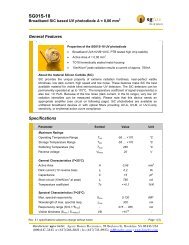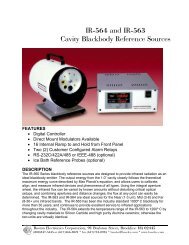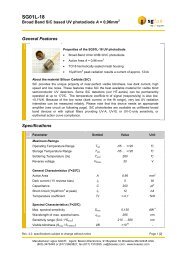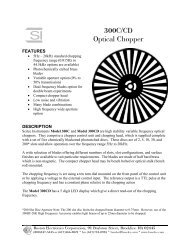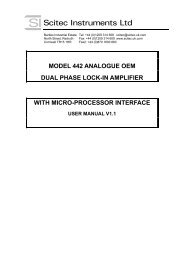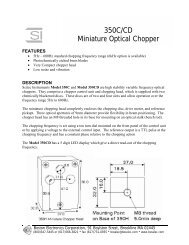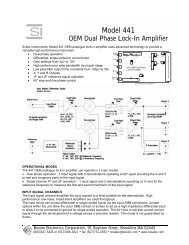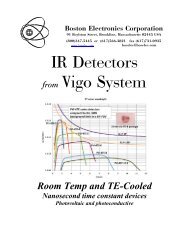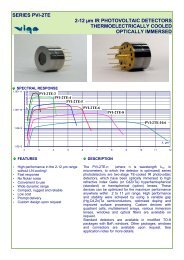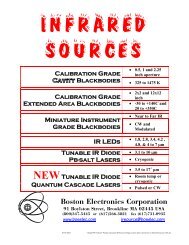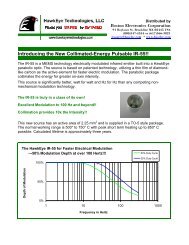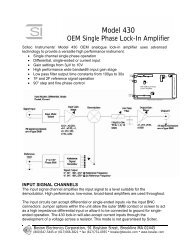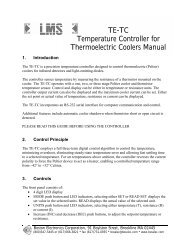TCSPC for FLIM and FRET in - Boston Electronics Corporation
TCSPC for FLIM and FRET in - Boston Electronics Corporation
TCSPC for FLIM and FRET in - Boston Electronics Corporation
You also want an ePaper? Increase the reach of your titles
YUMPU automatically turns print PDFs into web optimized ePapers that Google loves.
fluorescence photons the situation is less clear. It has also been found that photobleach<strong>in</strong>g is morerapid <strong>for</strong> two-photon excitation [41,42].For two-photon excitation the dependence of the photobleach<strong>in</strong>g efficiency on the excitation poweris highly nonl<strong>in</strong>ear. For photobleach<strong>in</strong>g versus excitation power exponents of 2.5 [45] <strong>and</strong> from 3 to5 <strong>for</strong> have been found [43]. At the same time the emission followed the excitation <strong>in</strong>tensity by theexpected power of 2. That means photobleach<strong>in</strong>g <strong>in</strong>creases more than l<strong>in</strong>early with the emission<strong>in</strong>tensity. There<strong>for</strong>e two-photon excitation can easily cause 10 times faster photobleach<strong>in</strong>g than onephotonexcitation <strong>for</strong> the same emission <strong>in</strong>tensity [43].Although photobleach<strong>in</strong>g is the most crucial constra<strong>in</strong>t <strong>for</strong> scann<strong>in</strong>g microscopy the question aboutthe excitation method is still open. The consequence from the controversial situation is not to relyon two-photon excitation alone. For all lasers commonly used <strong>for</strong> two-photon excitation frequencydoubl<strong>in</strong>g is available <strong>and</strong> delivers sufficient power <strong>for</strong> one-photon excitation.Signal Process<strong>in</strong>g TechniquesGated Image IntensifiersGat<strong>in</strong>g an image <strong>in</strong>tensifier is achieved by plac<strong>in</strong>g agrid beh<strong>in</strong>d the photocathode. The pr<strong>in</strong>ciple issimilar as <strong>for</strong> the grid <strong>in</strong> a radio tube. As long as thegrid voltage is negative referred to thephotocathode the photoelectrons cannot pass thegrid. When a positive pulse is applied the electronspass through the meshes of the grid <strong>and</strong> areaccelerated towards the multichannel plate or <strong>in</strong>tothe acceleration system.Although gat<strong>in</strong>g of an image <strong>in</strong>tensifier looks straight<strong>for</strong>ward at fist glance it is anyth<strong>in</strong>g but simple,particularly if sub-ns resolution is to be achieved. Even if a sufficiently short gat<strong>in</strong>g pulse can begenerated electronically the electrical field between the photocathode <strong>and</strong> the grid must follow thepulse at the same speed. Because the conductivity of the photocathode is relatively low the timeconstant <strong>for</strong>med by the gate-cathode capacitance <strong>and</strong> the cathode resistance limits the switch<strong>in</strong>gspeed. Furthermore, a variable lateral field builds up <strong>in</strong> front of the photocathode that distorts theimage <strong>and</strong> impairs the image resolution. Manufacturers counteract these effects by us<strong>in</strong>g highconductivity photocathodes which, however, compromises sensitivity. High efficiency GaAs <strong>and</strong>GaAsP photocathodes as they are used <strong>in</strong> PMTs have particularly low conductivity <strong>and</strong> are mostlikely not applicable <strong>for</strong> gated image <strong>in</strong>tensifiers.Another RC time constant exists between the grid <strong>and</strong> the multichannel plate. Although the changeof the field <strong>in</strong> front of the plate has only small <strong>in</strong>fluence on the gat<strong>in</strong>g per<strong>for</strong>mance it <strong>in</strong>duces alateral current <strong>in</strong> the multichannel plate that heats the device at high gate repetition rates.The gat<strong>in</strong>g resolution can also be impaired be electron-optical effects. When the gate voltage <strong>in</strong> thesetup of fig. 16 is negative a cloud of photoelectrons builds up between the cathode <strong>and</strong> the grid.When a gate pulse is applied to the grid these electrons pass the grid <strong>and</strong> enter the detection system.Depend<strong>in</strong>g on the grid geometry, the lifetime of the photoelectrons between the grid <strong>and</strong> the cathodecan be of the order of some 100 ps.The effects described above can be reduced by additional grids. Even then a lateral change of thegate delay due to the wave propagation <strong>in</strong> the grid structure rema<strong>in</strong>s. This effect is, however,predictable <strong>and</strong> can be corrected <strong>in</strong> the recorded data.Gatepulse-HVPhotocathodeGateMultichannel PlateFluorescence ScreenCCD CameraFig. 16: Gated Image Intensifier15



